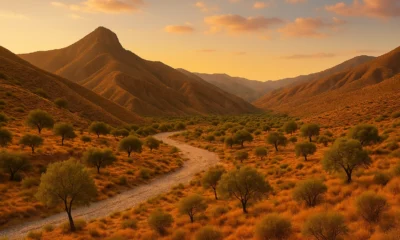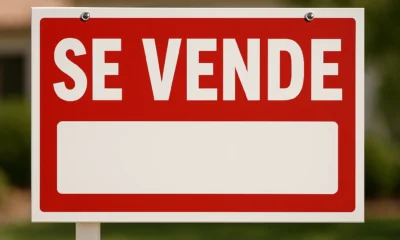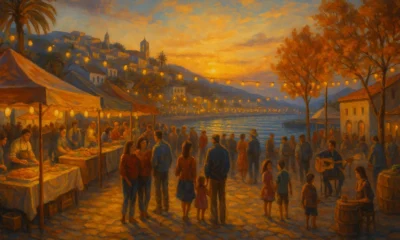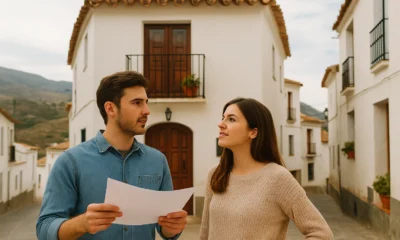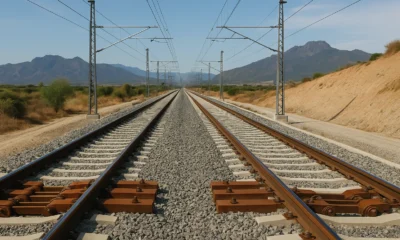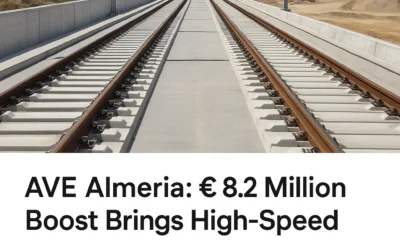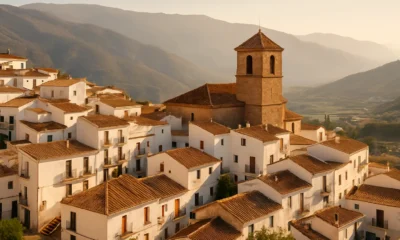Towns & Villages
Alcolea Guide. Discover Alcolea, Almeria — History, Nature & Local Life
Published October 21, 2025 | Category: Towns & Villages · Travel Tips
TL;DR: Alcolea is a peaceful Alpujarra village in inland Almeria, surrounded by olive trees, whitewashed houses, and timeless traditions. A destination for those seeking authenticity, mountain air, and slow-paced Andalusian life.
Table of Contents
Life Between the Mountains and the River
Tucked into the foothills of the Alpujarra Almeriense, Alcolea sits high above the Adra river valley — a cluster of whitewashed houses framed by olive groves and rugged mountains. Its narrow streets, terraced farmland, and peaceful rhythm make it one of the most authentic corners of inland Almeria. With fewer than 1,000 residents, Alcolea embodies the calm of traditional Andalusian village life, shaped by centuries of agriculture and history.
Visitors arriving from the coast will find a refreshing contrast: instead of beaches and palm trees, Alcolea offers mountain air, chestnut forests, and timeless architecture. Together with the smaller hamlets of Darrícal and Lucainena, it forms a municipality rich in heritage and natural beauty.
History & Heritage
The name “Alcolea” comes from the Arabic Alcolaya, meaning “small fortress.” The settlement traces its origins to Moorish Al-Andalus, when these hills were dotted with small fortified watchtowers protecting trade routes through the Alpujarra. After the Christian Reconquest, the village was repopulated with settlers from other regions of Spain, who rebuilt its terraced farms and churches.
The Church of San Sebastián, built on the site of an earlier mosque, stands at the heart of the old town. Just beyond the main square lies the Hermitage of San Sebastián and San Ildefonso, constructed in the early 18th century and still central to village life. Alcolea’s narrow lanes reveal traditional Alpujarra architecture — low white houses, flat roofs, and stone alleys adapted to the slope of the land.
You can explore the area’s heritage through the Ayuntamiento de Alcolea, which maintains records, local monuments, and cultural programming, or through the Diputación de Almería’s tourism department.
Nature, Rivers & Walks
Alcolea lies at about 730 m above sea level, surrounded by olive, almond, and orange groves. Below, the Río Adra winds through lush vegetation before flowing to the Mediterranean. The village’s setting is perfect for hiking, bird-watching, and photography, with views stretching across the valley to the Sierra Nevada peaks.
Short circular routes start directly from the village, such as a morning walk up to the “Cerro de la Cruz” viewpoint, or the trail following ancient irrigation channels once managed by Moorish farmers. More experienced hikers can explore nearby routes like the Sendero del Agua – El Castañar de Paterna, which links Alcolea with chestnut forests around Paterna del Río.
Nature enthusiasts can learn about local biodiversity via the Junta de Andalucía’s environmental portal, which lists protected areas, trails, and wildlife information for the Alpujarra Almeriense.
Culture & Local Life
Life in Alcolea revolves around its central plaza — a peaceful square lined with stone benches, where locals gather for conversation at sunset. Agriculture remains vital: olives and almonds are the backbone of the local economy, and every autumn, families meet to press olive oil in small traditional mills known as almazaras.
Throughout the year, the municipality organises small exhibitions, artisan markets, and cultural events with the support of the Diputación de Almería. Despite its modest size, Alcolea maintains a vibrant community spirit, with music, gastronomy, and inter-village sports keeping traditions alive.
Evenings in the Plaza
As daylight fades, the rhythm of Alcolea slows even further. The plaza fills with the scent of grilled tapas, laughter, and the chime of church bells. Visitors can enjoy a drink on a terrace while the mountain breeze cools the evening air. There are no loud nightclubs here — just the charm of summer evenings under the stars, punctuated by the occasional local festival.
Gastronomy — Olive Oil, Almonds & Mountain Flavours
Traditional Alpujarra cuisine dominates in Alcolea, hearty and rich in olive oil. Popular local dishes include:
- Migas alpujarreñas — fried breadcrumbs with garlic, pork, and seasonal vegetables.
- Gachas — a rustic flour-based dish often served with paprika and chorizo.
- Choto al ajillo — tender young goat cooked with garlic and herbs, a regional favourite.
- Hojuelas — delicate fried pastries dusted with sugar, made especially around festivals.
Many ingredients come directly from the surrounding land. Olive oil is locally pressed, almonds are harvested in late summer, and honey and figs add sweetness to desserts. For fresh produce and local wines, markets in nearby Laujar de Andarax or Berja are worth visiting.
Festivals & Events
Alcolea celebrates several traditional festivals each year. In January, the Fiesta de San Sebastián honours the town’s patron saint with bonfires, music, and a colourful procession through the streets. During the first week of September, the village hosts its main festival in honour of Santa Rosa de Viterbo — days of dancing, fireworks, and communal meals.
The Ayuntamiento de Alcolea posts annual schedules of local festivities and events. For province-wide holiday information, you can also consult Almeria Local Holidays 2026.
Getting There & Staying
By car: Alcolea is roughly 70 km from Almeria city, about an hour’s drive along the A-7 motorway and regional roads leading toward the Alpujarra. The route offers spectacular mountain scenery. Parking is available near the plaza and along the main access road.
Public transport: Limited regional bus connections operate between Almeria and Alcolea via Berja and Darrícal. Schedules vary seasonally — check with the provincial transport network.
Accommodation: Visitors can stay in small guesthouses and rural apartments within the village or nearby hamlets. For a countryside experience, the region also offers casas rurales surrounded by orchards and vineyards. Local listings are available through the Diputación’s Costa de Almería website.
Itineraries & Day Trips
- One Perfect Day: Morning walk to the “Cerro de la Cruz” viewpoint → picnic by the river → siesta under the olive trees → tapas crawl at sunset in the plaza.
- Nature Trail: Early hike through terraced groves → visit the chestnut forest near Paterna del Río → return for dinner in Alcolea.
- Cultural Route: Explore the Church of San Sebastián, the Hermitage, and nearby Darrícal and Lucainena for their small museums and traditional architecture.
Practical Information — Alcolea
- Town Hall (Ayuntamiento): Plaza de la Constitución, Alcolea — official information via alcolea.es
- Tourism & Culture: Provincial updates via Diputación de Almería
- Environment & Trails: Nature data via Junta de Andalucía – Medio Ambiente
- Weather Forecast: Local updates via AEMET
- Emergency Numbers (Spain): 112 (General) · 061 (Medical) · 062 (Guardia Civil) · 091 (National Police) · 085 (Fire)
For more village guides across the province, visit our Towns & Villages section — and explore more local travel ideas aznd what to do in Almeria in Travel Tips.
Towns & Villages
Moros y Cristianos Vera 2025: Big parade on Saturday + full weekend program
Published October 25, 2025 | Category: Activities & Attractions
TL;DR: The III Andalusian “Moros y Cristianos” meeting is underway in Vera this weekend. Saturday is parade day; Sunday brings a guided visit to historic Bayra and the official closing.
Moros y Cristianos Vera 2025: what’s happening this weekend
Vera hosts the III Andalusian Meeting of Moros y Cristianos from Friday to Sunday, bringing together associations from across Andalusia for a weekend of history, costumes and music. The event combines civic acts, talks, performances and a standout parade on Saturday.
Key times
- Friday (evening): Opening at Auditorio Ciudad de Vera, welcome session and roundtable on the tourism potential of these historic fiestas. Festive atmosphere continues at the Recinto Ferial.
- Saturday (main day): Morning association activities and staged performances; big parade in the afternoon (starts from the fairground and runs through central streets). More performances and music afterwards.
- Sunday (closing): Guided visit to the archaeological site of Bayra on Cerro del Espíritu Santo, followed by an exhibition in Vera and the official closing around midday.
Where it takes place
The weekend program is centered around the Auditorio Ciudad de Vera for the opening and the Recinto Ferial El Palmeral for the parade and festivities, with the Sunday visit to the historic hill of Bayra.
Who will enjoy it
Great for families, culture lovers and photographers. Expect colorful costumes, traditional music and a lively street atmosphere. If you’re staying in the Levante area (Vera, Garrucha, Mojacar, Cuevas), this is an easy, unmissable day out.
Practical info & official links
- Official association info: morosycristianosvera.com
- Municipal agenda & updates: vera.es
Note: Timings may adjust slightly due to logistics; check the official pages on the day for last-minute changes.
For more updates from across the province, visit our News category.
Towns & Villages
Alcontar Guide. Discover Alcontar, Almeria — Mountains, Hiking & Authentic Andalusian Life
Published October 23, 2025 | Category: Towns & Villages · Travel Tips
TL;DR: Alcontar is a peaceful inland village in the Almanzora Valley, known for its whitewashed houses, fresh mountain air, scenic walking routes and traditional Andalusian life.
Alcontar Guide. Discover Alcontar, Almeria
Table of Contents
- Introduction
- History & Heritage
- Nature & Walking Trails
- Culture & Local Life
- Gastronomy
- Festivals & Events
- Getting There & Accommodation
- Itineraries & Day Trips
- Practical Information
Introduction: A Hidden Gem in the Almanzora Valley
Nestled in the heart of the Almanzora Valley, the village of Alcontar offers a quiet and authentic Andalusian escape. Surrounded by olive groves and framed by the dramatic Sierra de los Filabres, it sits at nearly 950 metres above sea level. Life moves at a gentle pace here — mornings filled with birdsong, evenings cooled by mountain breezes, and a community that still cherishes its rural traditions.
Visitors come for the unspoiled landscapes, crisp air and the opportunity to experience rural Almeria at its most genuine. The municipality also includes smaller hamlets like El Hijate, each preserving their own slice of history and culture.
History & Heritage
The name “Alcontar” likely derives from the Arabic al-qantara — meaning “the bridge” — reflecting the ancient river crossings that once connected this valley to surrounding settlements. Human activity here dates back millennia, with archaeological findings suggesting Roman and Moorish influence throughout the Almanzora region.
Historic remnants like the Torre del Ramil, an old watchtower, remind visitors of Alcontar’s strategic past during the period of Moorish rule. Later, in the 19th century, the municipality gained autonomy, and the distinctive whitewashed architecture that defines today’s village began to flourish.
Nature & Walking Trails
For nature lovers, Alcontar is a paradise of mountain paths, dry riverbeds and quiet forest trails. The area is part of the Sierra de los Filabres natural environment — one of Almeria’s most scenic inland landscapes.
Popular local walks include the short ascent from the village to natural viewpoints overlooking the Almanzora Valley, as well as marked routes such as PR-A 12 and PR-A 72, which weave through pine forests and ancient irrigation channels.
In spring, wildflowers carpet the hillsides, while autumn brings golden tones and clear skies perfect for hiking. Even in summer, temperatures remain cooler than the coast thanks to the altitude.
Culture & Local Life
Life in Alcontar revolves around the central plaza and the Church of Nuestra Señora del Rosario, built in the early 19th century. Here, you’ll find a small fountain, shaded benches and the relaxed rhythm of local conversation.
Farming remains at the heart of the economy — almonds, olives and cured meats are local staples. Artisanal honey and homemade pastries can be found at small village shops or local fairs. Don’t expect bustling nightlife — instead, evenings here are about quiet streets, friendly bars and the sound of crickets in the distance.
Gastronomy
Traditional mountain cuisine defines Alcontar’s food culture. Popular dishes include:
- Migas: Fried breadcrumbs with chorizo and peppers, a classic comfort meal after a day outdoors.
- Olla de trigo: A rich wheat and meat stew typical of inland Almeria.
- Local cured meats: Particularly ham and sausages from nearby farms.
Desserts often feature figs, quince or almonds — try hornazos or homemade fig jam. Pair your meal with a glass of red wine from the Almanzora Valley, known for its full-bodied and earthy flavour.
Festivals & Events
The village celebrates its patron festival in honour of the Virgen del Rosario every October, featuring processions, live music and community gatherings. In the nearby hamlet of El Hijate, the annual June festival of San Antonio de Padua brings together residents for traditional dances and open-air feasts.
Visitors are warmly welcomed during these fiestas — they are a chance to experience genuine rural Andalusian celebration, complete with fireworks and homemade food.
Getting There & Accommodation
By car: Alcontar is around 95 km north of the city of Almeria (about 1 hour 15 minutes by car) via the A-92 and local roads through the Almanzora Valley.
By public transport: Limited options — driving is recommended.
Accommodation: Small rural houses and guest lodges (casas rurales) dominate. Staying overnight allows visitors to enjoy the mountain tranquillity, starry skies and local hospitality.
For up-to-date local information, visit the official Ayuntamiento de Alcontar website or check regional listings via the Diputación de Almería.
Itineraries & Day Trips
- Half-day walk: Follow the village fountain trail to nearby terraces for panoramic views of the valley.
- Full-day hike: Explore the pine forests of the Sierra de los Filabres on foot, with picnic spots and old stone farmhouses along the way.
- Day trip idea: Combine Alcontar with the villages of Bacares or Seron for a full mountain-culture itinerary.
Practical Information
- Altitude: 954 m above sea level.
- Population: Approx. 660 inhabitants.
- Area: 93.9 km².
- Climate: Mild mountain climate — cooler nights, dry summers, ideal for hiking in spring and autumn.
- Emergency numbers (Spain): 112 (General) · 061 (Medical) · 062 (Guardia Civil) · 085 (Fire).
For more rural destinations across the province, visit our Towns & Villages section or check our Travel Tips for routes, itineraries and local insights.
-
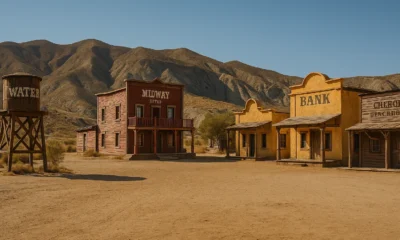
 Events1 month ago
Events1 month agoAlmería Western Film Festival 2025: Honoring Charo López, Roque Baños and More
-
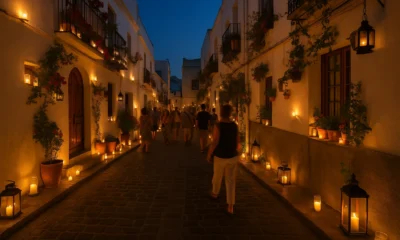
 Activities & Attractions1 month ago
Activities & Attractions1 month agoNight of the Candles in Mojácar: village aglow on September 20
-

 Activities & Attractions1 month ago
Activities & Attractions1 month agoAlmería Cultural Agenda: Best Events This September & October 2025
-
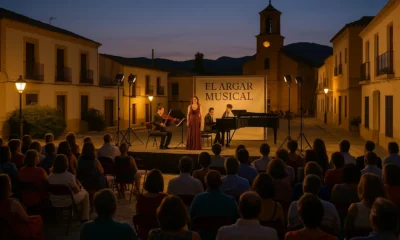
 Events2 months ago
Events2 months agoEl Argar Musical Festival 2025 Recap – Opera and History in Antas






















